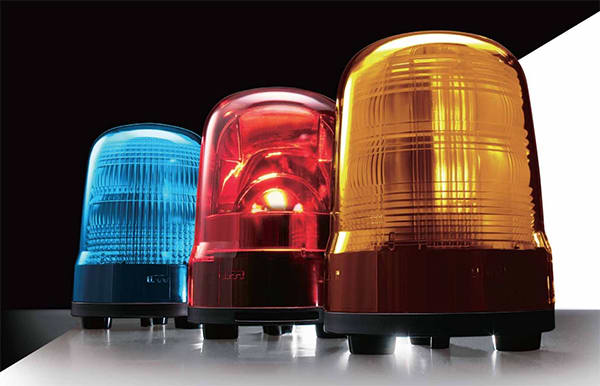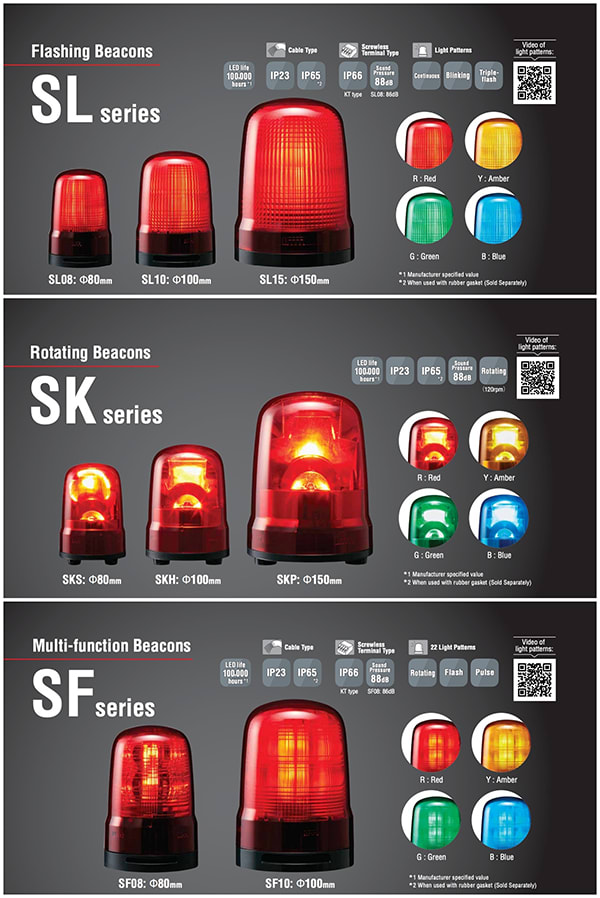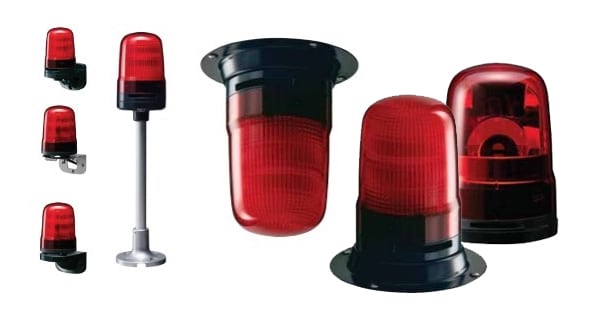James Patrick, Marketing and Product Manager, PATLITE USA
Signal beacons are unlikely to rank high on the list of discussion topics about industrial mechanical systems because, although critical, beacons in many applications remain dormant for weeks or months. But as far as health and safety are concerned, signal beacons are amongst the most important elements in a mechanical system design. When any change in the status quo that could be hazardous to those around the application occurs — be it a rise in toxic airborne chemicals, the impending start or stop of a mass transportation system such as a train or escalator, or the triggering of a security system — signal beacons illuminate to get peoples’ attention, indicate that danger is imminent or equipment is malfunctioning, and potentially even identify the source of the issue.
PATLITE signal beacons have fulfilled this critical safety role since the company was founded in 1947. “The invention of the micro motor in 1955 led to the development of our first revolving beacon in 1965 and was essential to PATLITE’s evolution,” said James Patrick, marketing and product manager at PATLITE USA. “Since then, we have grown to make many different types of safety signaling equipment, and today we are ranked number one globally for signaling devices.”
In this edition of RS’s “Ask the Expert” series, we’ll explore four interesting facts about signal beacons and visual signaling devices that aim to not only bring attention to a critical but often overlooked part but to help prospective customers select the best signal beacon to fit their needs.
There is more to signal beacons than flashing lights.

If you believe that signal beacon technology has remained relatively unchanged for the last 60 years, you are sorely mistaken. As technology has advanced, so have the demands on beacon equipment providers to ensure a high standard of safety, which has necessitated the introduction of features that go far beyond a single flashing light.
“In the early days of signal beacons, they were strictly intended to alert people of impending danger, so they only featured the most basic functions: steady or flashing light,” said Patrick. “In recent years, demand for multifunctional signal beacons has grown. These newer beacons fulfill multiple signaling needs, including various audible alerts, capacitive touch sensors, multi-color indicators, and multiple flash patterns, all of which can also communicate the source of the danger or equipment abnormality.”
Signal beacons are used in more places than you think.
Due to widespread representation in pop culture, the first images people tend to associate with signal beacons likely involve prison, bank, or school security systems, which is fair since these are solidly amongst the most common applications. “For instance, in a school security system, a beacon over the door can alert the security staff of an approaching intruder,” said Patrick.
However, while security systems are a common place to find signal beacons, they are certainly not the only place. “Beacons are also found on manufacturing and engineering control panels,” said Patrick. “Panel-mounted beacons are incredibly important because they provide an immediate alert instead of escalating alerts like signal towers. I have also found beacons in hardware stores that warn people when a machine is operating. Escalators, which use beacons in the case of emergencies, are another good example. Since signal beacons can warn people anytime there’s something out of the ordinary, the applications are nearly limitless.”
Signal beacons come in many varieties.
When exploring the various types of signal beacons available on the market, it quickly becomes apparent that there are more selection criteria than beacon size and whether it’s capable of being turned on and off.
“There are several fundamental questions you need to ask before choosing a signal beacon solution,” said Patrick.” “What kind of security or indication are you looking for? What characteristics and functions do you need? For example, what size and color should the beacon be? How visible does it need to be in terms of environment and distance? Do you require any flashing or rotation, and does it need to include an alarm? Is your application compatible with simple on/off wiring, or does it require something more? Are you interested in a slow pulse for normal operation and a triple pulse for an alert? Is there a power requirement? Is the application in an area that requires a high IP rating? How do you want it to connect to the system, and is there a mounting location requirement? There’s a lot of ground to cover given the wide variety of traditional to multifunctional signal beacons available on the market.”
PATLITE offers a wide range of signal beacons for many uses, including a product portfolio featuring three different lines of S Series signal beacons: The SL Series, the SK Series, and the SF Series. Although all three lines share several basic commonalities, they also offer unique, series specific features designed to provide customers with a wide range of functionalities designed to suit their specific needs.
“All of our S Series signal beacons are indoor and outdoor rated, mountable in all directions (upright, sideways, or upside down), and available in two or three sizes with colored housings, colored LEDs rated for 100,000 hours, and AC and DC power wiring, and with or without a buzzer. Select signal beacons are also available with higher than standard IP ratings up to IP66,” said Patrick.

Signal beacons are highly customizable.
PATLITE’s three S Series signal beacons also offer enormous leeway for customization and can be made to overcome any installation challenge or satisfy even the most unusual application requirements. For example, PATLITE signal beacons are available with an extensive selection of optional accessories including brackets for wall, ceiling, or pole mounting and rubber gaskets for enhanced IP ratings. For particularly unique projects, PATLITE has even created a beacon configurator that allows customers to build their own beacon from scratch. Using this tool, customers can define custom voltages, diameters, IP ratings, and more.

The installation process for PATLITE signal beacons is fairly straightforward given a basic understanding of wiring diagrams. According to Patrick, the biggest challenge is making sure you purchase the correct equipment for the mounting option you choose. To help with this challenge, PATLITE offers several different customer resources. AutoCAD sheets, spec sheets, and wiring diagrams can be found on the SL, SK, and SF Series product pages and, during Pacific Time business hours, technical engineers are happy to provide more detailed support.
“No matter the challenge, there is a very good chance we can collaborate with our customers to find a signal beacon that ideally suits their needs,” said Patrick. “All they have to do is reach out.”
Additional Links:
- VIDEO: PATLITE SK/SL/SF Series Signal Beacons
- RS Electronics’ PATLITE Channel
- PATLITE SL/SK/SF Series Signal Beacons Brochure







